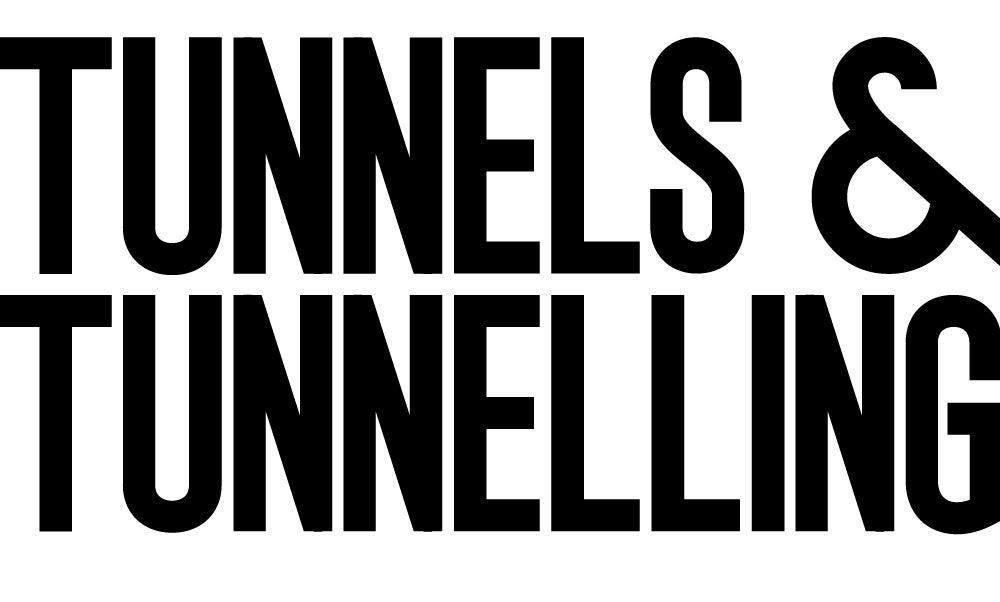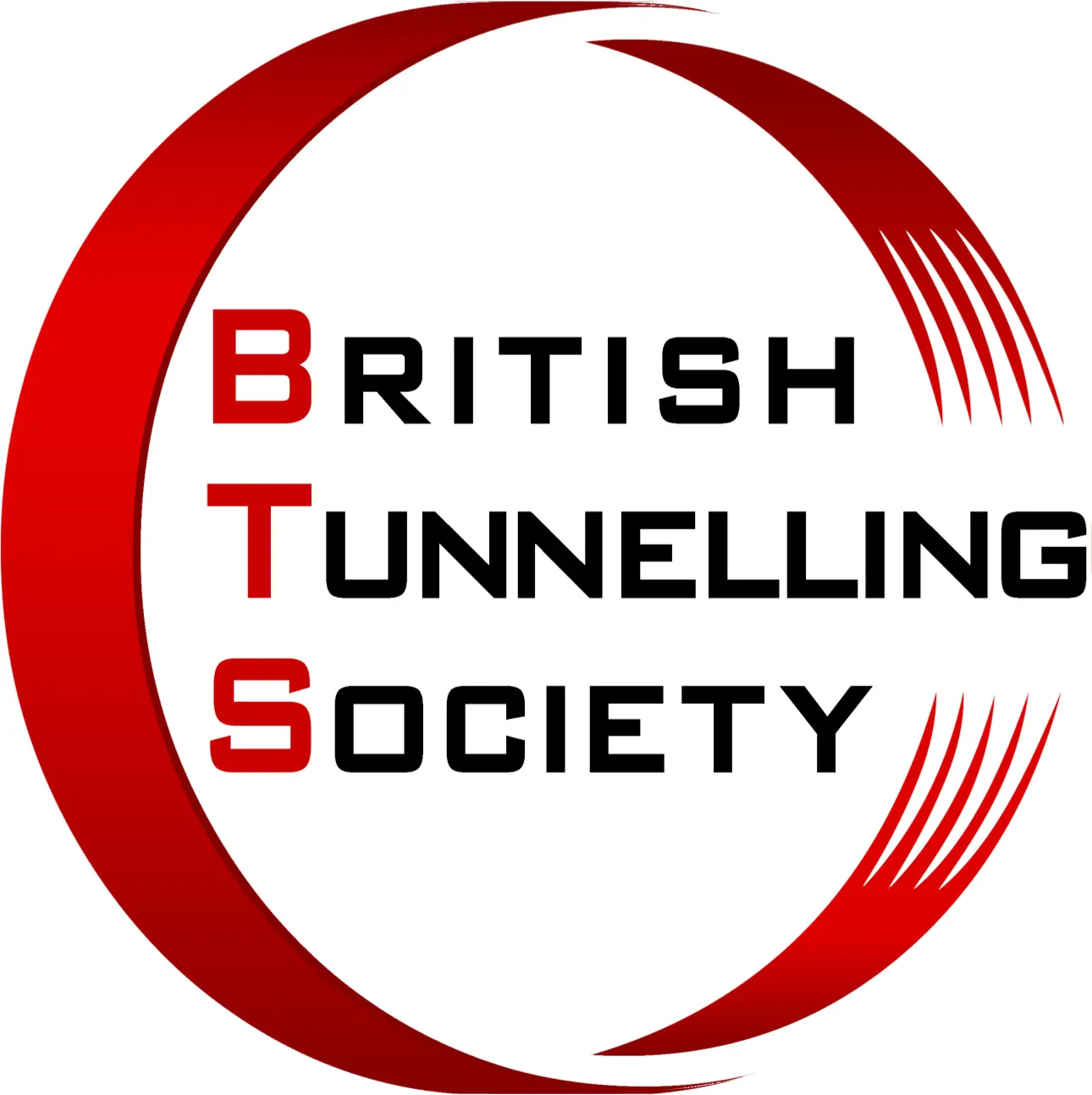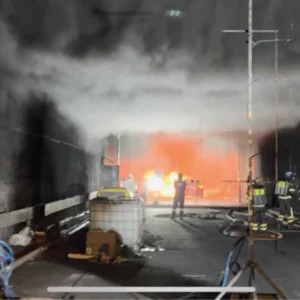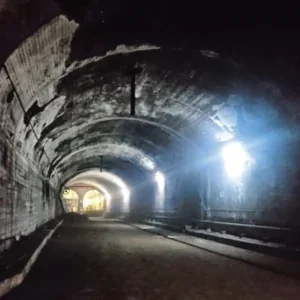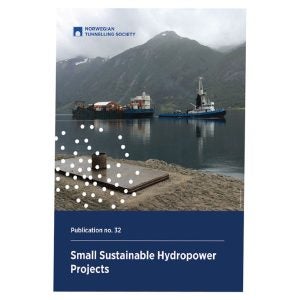To mark the 50th anniversary of the founding of the People’s Republic of China, the government nominated a number of major projects to celebrate the October 1 1999 event. One of the more notable would be the breakthrough of the 18.5km long Qinling Tunnel on the Xi’an-Ankang electrified rail line through the Qinling Mountains in Shaanxi Province. This is the longest rail tunnel under construction in China and is the critical path element for the entire $1.2bn scheme (see box, left).
On August 22, the TBM driving from the south broke through into the southern reception chamber, while the second machine, advancing from the north, broke through into a mirror chamber on the 29th, having set a new project record of 528m in one month. The south portal TBM, operated by the 18th Construction Bureau of the China Railway Construction Corporation, completed 5621m in 18 months, with an average of 338.7m/month and a best of 518m/month. The north portal machine, operated by the Tunnel Engineering Bureau (TEB) of the China Railway Engineering Corporation, completed 5255m in 19 months.
However, these bald statistics do not tell the whole story: a significant 6.4km long central section of the tunnel had to be excavated by drill+blast to meet a revised schedule and to compensate for teething problems and operational difficulties with the TBMs, which struggled to achieve their designed production rates during the early stages of the project.
Largest TBMs in China
The $60m contract for two sets of 8.8m diameter TBMs and back-up trains was signed in October 1996 between Wirth and the China National Technology Import Corporation on behalf of the Ministry of Railways (MoR). These would be the largest TBMs yet used in China, and the first to be bought by the MoR and operated by Chinese crews. The order included supply of consumables and spares, and technical assistance. More than 100 Chinese engineers were trained; an experienced TBM engineer from Amberg Consulting Engineers of Switzerland was to be present for the first three months; and continuous technical support was to be provided by Wirth.
The comprehensive package included Mühlhäuser muck cars; Schöma diesel locomotives; ventilation fans from the Howden Group; Putzmeister shotcreting systems; grouting equipment from Häny; Tamrock probe and rockbolting drill rigs; segment moulds from CBE of France; and other back-up systems subcontracted to Rowa in Switzerland and Baoji in China.
However, as it had been agreed to use high-speed hard rock TBM technology to ensure adherence to the construction programme, consultation on detailed design continued until April of the next year. The first set of equipment was therefore not shipped from Europe until July 1997, with the second following a month later. The three month assembly process was further complicated by space restrictions at the portals, especially at the northern end, where the full back-up train could not be assembled until the TBM had moved into the tunnel.
Problems started as the steep learning curve faced by the Chinese personnel and the Chinese New Year shutdown meant that the commissioning period for the first machine was longer than planned. Boring started in January ’98 (north portal), and the 1000m drive was finished in May; commissioning at the south end started in February and was also completed in May.
Rock at the start of the northern drive was less easy to penetrate than expected, resulting in lower penetration rates, higher cutter consumption and downtime for cutter replacement. In the south, the geology proved to be as expected and cutter consumption was lower than predicted. This situation was to be reversed later in the project.
Originally, the project was planned with an average monthly penetration rate of 350m/TBM, which required a total boring operation of 26 months for a breakthrough in spring 2000. However, by bringing the deadline back to October 1, the client recognised that, to guarantee breakthrough, it would have to augment the TBM drives by a central drill+blast section with access from the parallel pilot tunnel. The length of this section would depend on the performance of the TBMs but would be kept to a minimum because of cost.
As a result, according to the South West Research Institute, drill+blast started in the central section of the Qinling Line 1 tunnel in July 1998, although there is some confusion over this date as the Tunnel Construction Bureau told T&T International that it began on April 1 1998, before the end of TBM commissioning.
At T&T International’s 1998 Chinese Symposium in Beijing, senior engineer Mr Li Dianhuang told delegates that the TBMs were fitted with cutters for Class 4 granite but had encountered Class 5 gneiss, with average compressive strength of 180MPa, up to 200MPa in places, with small inclusions of very hard rock (later found to be dykes). He reported that cutter consumption had been three times that expected, with over 600 discs consumed in just 1km. Penetration (0.7-1.6m/h) in the worst material could only be achieved under full design thrust of 250kN/cutter. In addition, damage to two of the northern machine’s eight planetary gear boxes had reduced its effectiveness.
Investigations by the manufacturer and client sought to determine the reasons for this disappointing performance, and debate centred on whether the design specification corresponded to the ground conditions actually encountered on site. By December 20 1998, the TBMs had excavated 2807m on the north side and 3462m on the south.
Further setbacks included problems with the electrical system and pollution of the hydraulic pressure system. In the end, damaged gear box units were removed, modified and replaced. Last autumn, replacement of a faulty main bearing seal on the north portal machine was also necessary, and cracks were found in the cutterhead of the northern machine, and operations were stopped while 16 cracks were repaired during five days of 24h working. In all, five sets of cutterhead repairs were performed on this machine during the 19 month drive, according to the Chinese.
Wirth says that oil leakage of one centre cutter was not recognised by the operating crew’s night shift and subsequently all the other centre cutters became damaged. According to the manufacturer, the whole central part of the cutterhead was worn, leaving a central, dome shaped block approximately 300mm high.
One theory advanced by the client for this cracking is fluctuating stresses in the cutterhead induced by stresses in the rock face. Experience from the Gotthard tunnel in Switzerland indicates that excavation of a parallel pilot tunnel may have magnified this effect. Despite these difficulties, both machines eventually recorded advance rates far above their 350m/month design rates and have been formally accepted by the client.
When T&T International visited the site earlier this year, drill+blast operations were almost complete and the TBMs were approaching the end of their drives.
South portal
The south portal is reached by a 3h drive from Xi’an through spectacular but largely inaccessible mountains along roads often closed by landslides, flooding and bad winter weather. At the time of the visit, drill+blast operations were complete on the main tunnel alignment and only 260m of TBM excavation remained. Deputy project director for No. 18 Bureau, Mr Li, told T&T International that the major problems faced during the 9000m excavation were ventilation on the long drive; the hard rock, up to 325MPa; and the high pressure and rock bursting caused by the 1.6km overburden. Temperatures of up to 40° and water ingress were also a problem, jetting 2m in places.
Drill+blast in the central section was used to excavate 2800m on the southern contract, using three faces of 8 x 6m, with an average advance rate of 245m/month achieved. Five drill rigs from Atlas Copco and Norwegian manufacturer AMV were used at the peak of operations. At the time of the visit, an Atlas Copco B353E manual drill rig had just completed the final face. Up to 17.9m/day was driven, with 96 blast holes/face, each 5.5m long. Maximum monthly advance rate for the B353E rig was 338m. Support was provided by rockbolts at a minimum of 500mm centres, and shotcrete. Where conditions dictated, steel arches were installed every 900mm.
Ventilation of the drill+blast central operations was performed via Line 2. Extracted air was transported along ducts and vented via a vertical shaft 1410m from the pilot tunnel’s south portal. The Howden fan used provided 2000 cu m/min; no intermediate boosters were needed.
Drill+blast was also used to excavate the 5 x 6m cross passages every 400m. The southern section featured 21, three of which had to be constructed to allow access for drill+blast operations in the central section.
Li confirmed that the hard rock (82-325MPa) had made TBM advance very slow in places on this contract. He noted that discs had lasted a maximum of 8m and a minimum of 1m before being changed.
North portal
At the northern contract, the TEB was responsible for driving 9500m of tunnel. The central drill+blast works were carried out as a subcontract by Bureau No. 1, which had previously completed the northern section of the record breaking pilot tunnel, Line 2, using a Promec TH 586-5 gantry jumbo and two H178 boomers from Atlas Copco. The former achieved a maximum monthly advance of 456m. This 50 tonne gantry jumbo had four booms and a service basket and was fitted with COP 1238 ME rock drills.
On the central section of Line 1, 3630m of drill+blast was excavated by hand drilling, gantry jumbos and wheeled jumbos. Work advanced on six faces, with four connecting tunnels to Line 2. Most of the excavation – 2000m – was performed by the gantry machine.
Drill+blast on the main alignment finished on July 18. Here again, rock was Class 3-6, up to 325MPa, but, in contrast to the southern section, water penetration was low. Maximum drill+blast advance was 555m/month. The 50m2 working surface required 130 holes, each 4.5m deep, giving an advance of 4.3m/round. Some hot rocks and rock bursting were encountered, together with some sections of fractured rock.
Howden booster fans were used to draw air from the drill+blast operations in Line 1 into the pilot tunnel and vent via an inclined shaft 4km from the northern portal of Line 2.
According to the TEB, there were 71 discs on the TBM cutterhead and, on average, 120 were replaced every month during the contract, with implications for time and cost. On completion of their truncated drives, both TBMs broke through into 50m long x 16m wide x 22m high dismantling chambers prepared by drill+blast.
While reluctant to discuss the cost of additional drill+blast operations on the project, one MoR engineer ventured that every metre of rock removed by drill+blast could have added an extra $600 to the contract price.
Lessons learned
Both parties admit to having found the project challenging. Wirth faced teething problems and had to rectify mechanical problems while dealing with the logistical nightmare of supporting machines half a world away in a remote part of China.
According to Wirth managing director Niko Kleuters, the TBMs performed well whenever the ground conditions allowed. “We have been through a tough learning curve – even for a company as experienced as Wirth – and we have learned a lot from this project.” He acknowledged the less than smooth ride the machines had enjoyed. “We have had some problems, but they have always been solved in a professional manner with little or no disruption to the project.” He pointed out that a good relationship had been maintained throughout, both machines had been formally accepted, and resolution of all claims and outstanding matters achieved.
The learning curve for the Chinese has been steep and protracted as they have had to cope with unfamiliar technologies. But they have achieved a lot to come to terms with co-ordinating the hydraulic, electronic, mechanical and civil engineering aspects of modern TBM tunnelling. The experience gained on Qinling will enable tunnelling in China to move into the 21st century using the most modern technologies available.
Related Files
Geological Profile
Cross section
